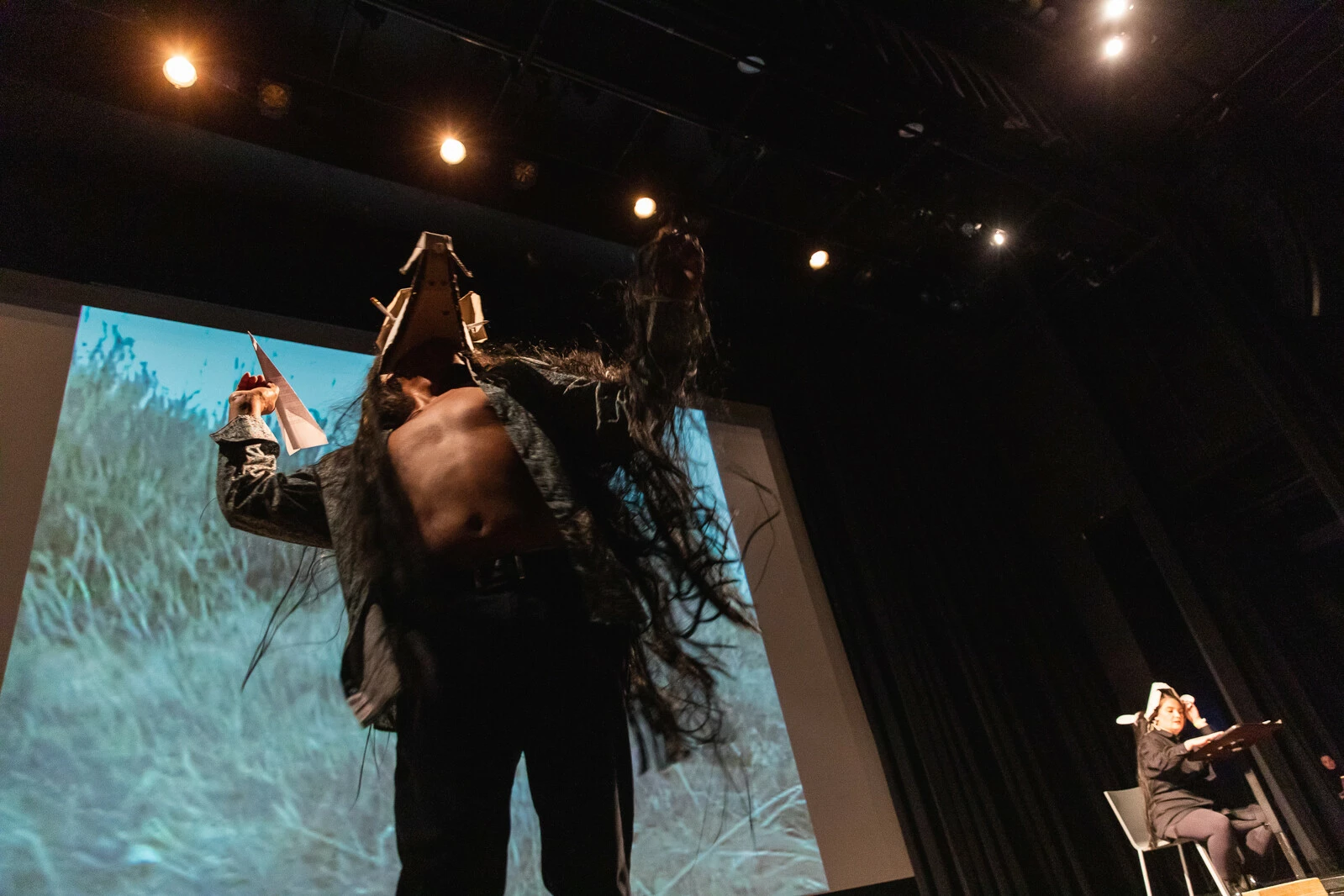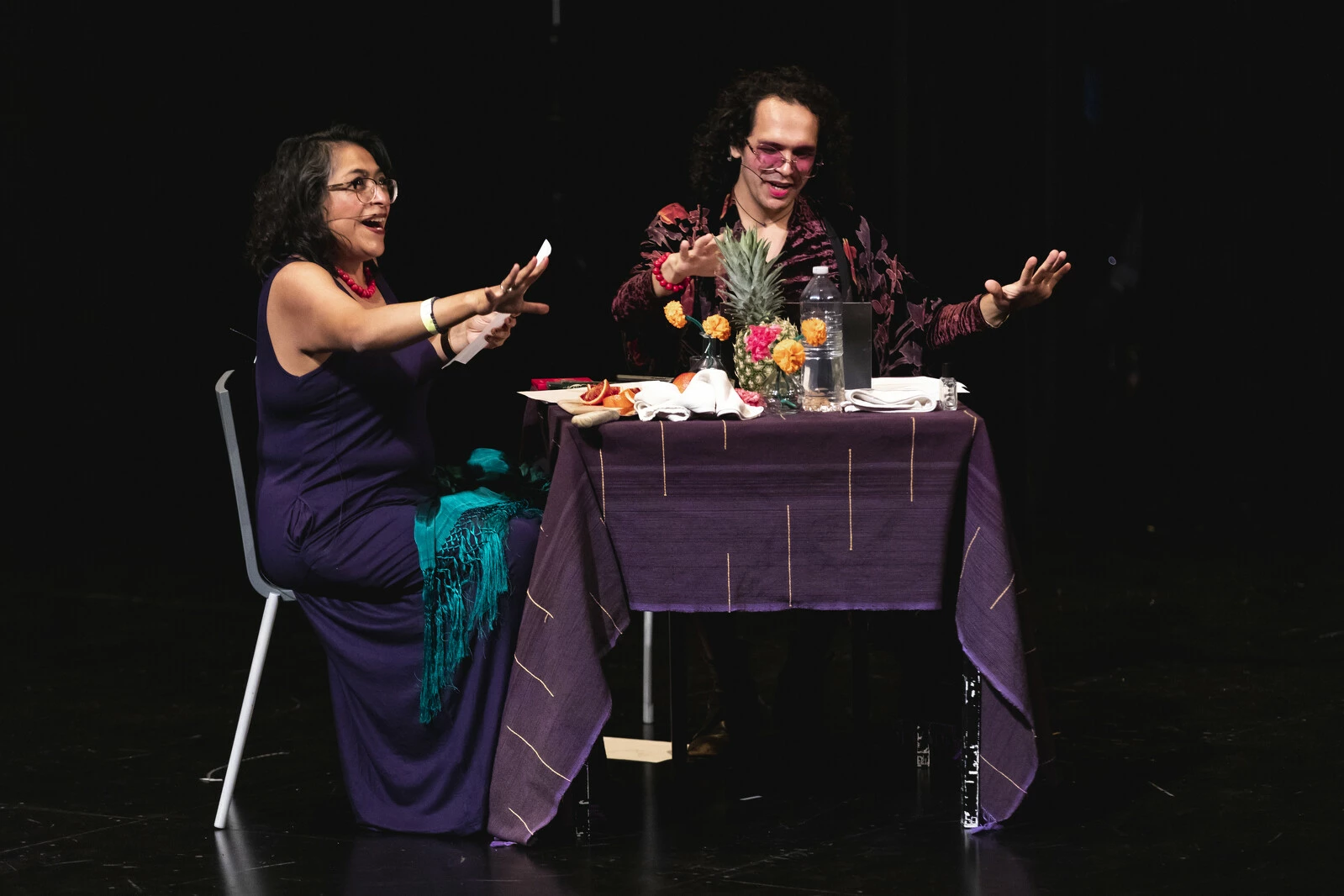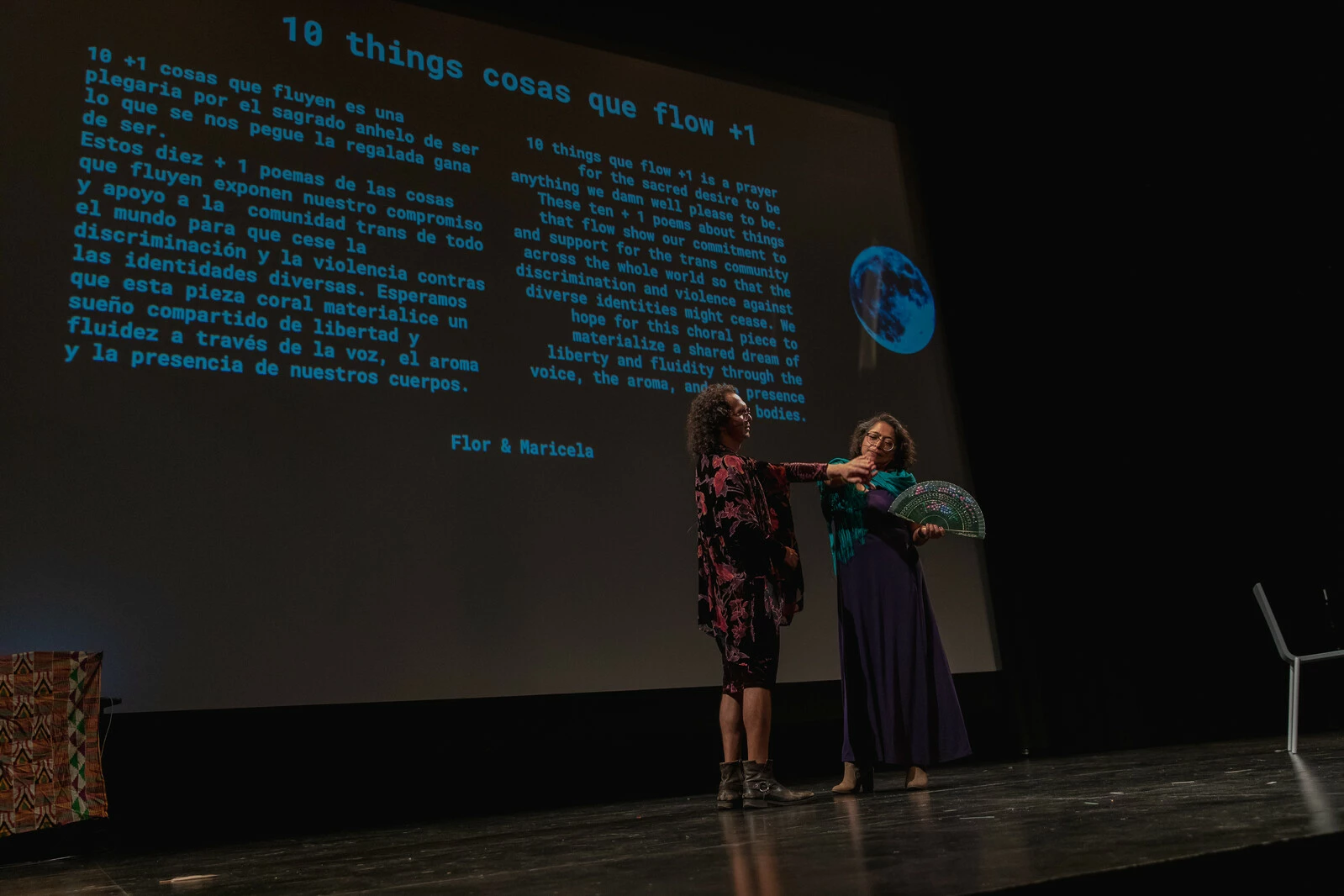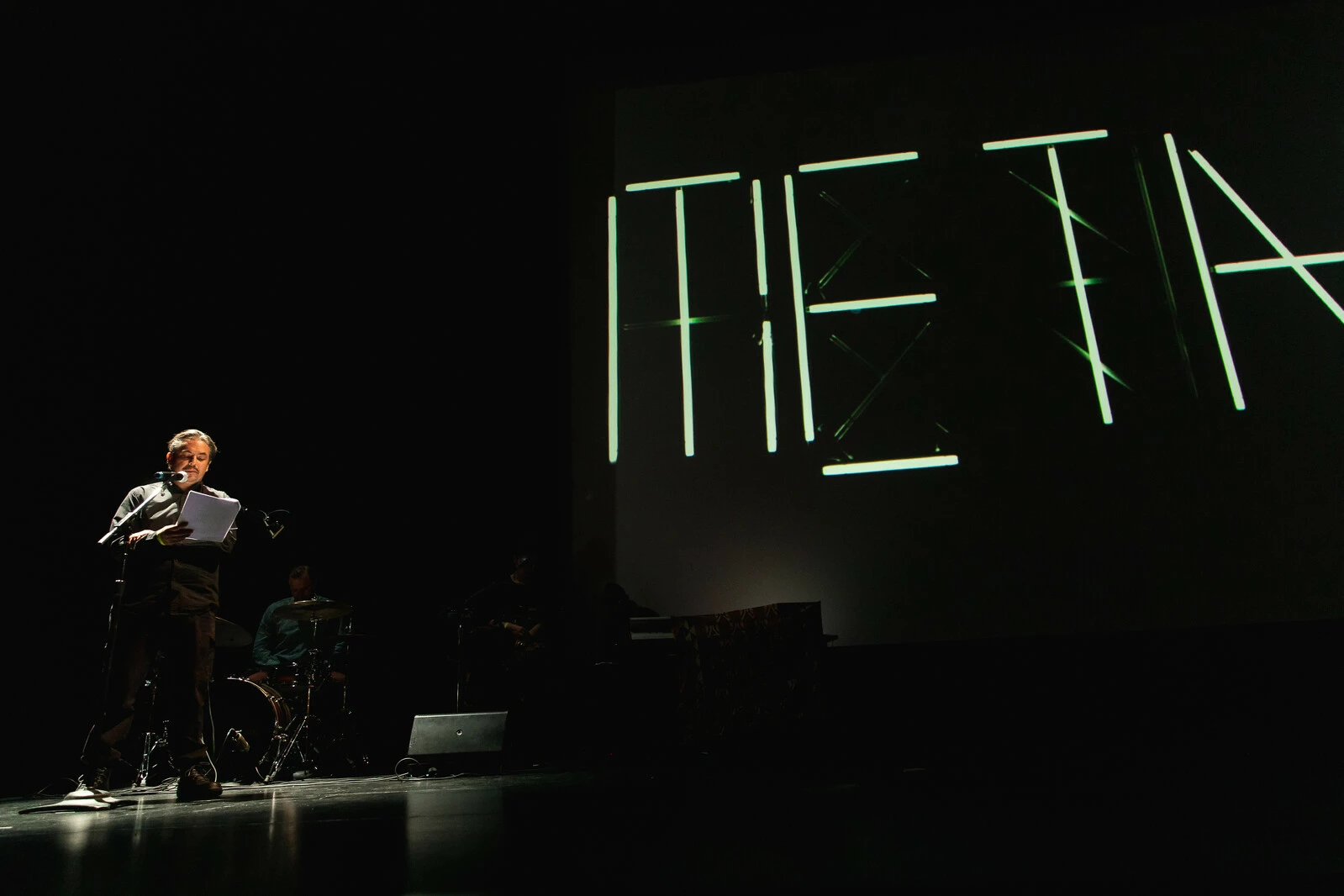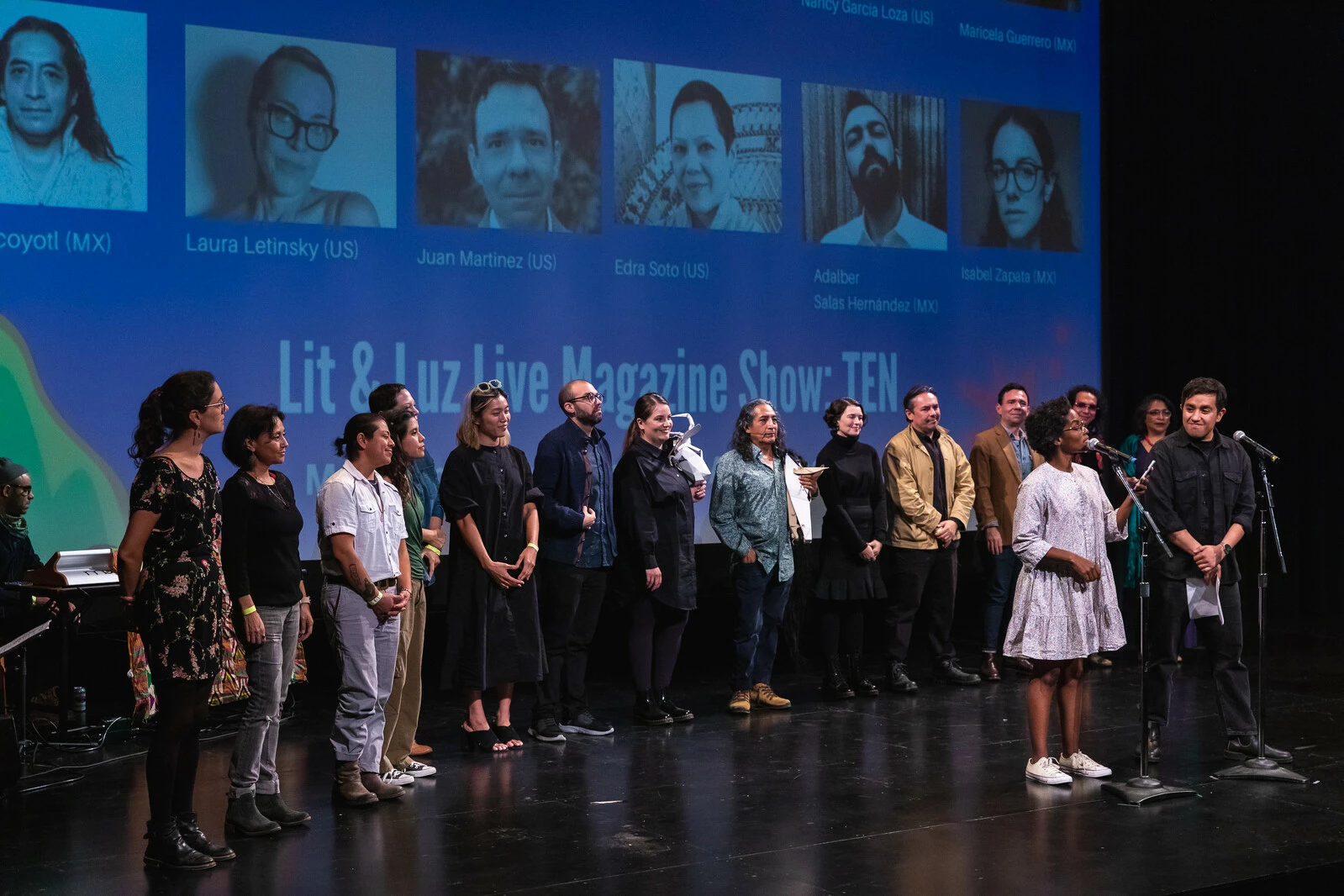Live Arts | Lit & Luz Festival: Live Magazine Show
November 02, 20247:00 pm - 9:00 pm
English/Spanish audio translation provided
About the Event
Each year, the Lit & Luz Festival supports the creation of new, collaborative art by placing writers, visual artists, and musicians from Chicago and Mexico in conversation with one another. The theme of the 2024–25 festival is “Saturation/Saturación,” and features work presented in both Spanish and English.
English/Spanish audio translation is provided for this event.
About the Collaborators/Sobre los colaboradores
English
Alberto Aguilar is a Chicago-based artist that uses life stuff as a pliable material to create a meaningful connection with the viewer. This could include language, everyday objects, or actual situations he finds himself in. Through their reconfiguration, subversion, and juxtaposition a new meaning reveals itself. He doesn’t distinguish his art practice from other various life roles, which provides freedom, allowing him to be more careful and present in situations. Aguilar utilizes a self-imposed framework that gives him clear direction producing a generative and prolific output. He chooses to create outside of a studio setting in order to interact with others and experience the world more fully. Through asking questions and an openness to being directed by people and his surroundings, he regularly collaborates with others. Although written in third person, the artist arranged these 300 words you are now reading in order to have a shared moment with you. What were you doing prior to reading this bio?
He is a 2024 US Latinx Artist Fellow and a recipient of the 3Arts award. He has shown at various museums, galleries, storefronts, and street corners around the world, including: Queens Museum (NY), El Torito Supermercado (St. Louis), Minneapolis Institute of Art, outside of the Dollar General on US-56 (Elkhart, KS), Museum of Contemporary Art (Detroit), the entrance of Chicago City Hall, Museum of Contemporary Art (Chicago), Parque Fe Del Valle—a designated wifi area (Havana, Cuba), National Museum of Mexican Art (Chicago), El Cosmico Trailer Park (Marfa, TX), El Lobi (San Juan, PR), and an I-80 rest stop (Iowa). Along with his daughter, Madeleine, he runs Mayfield, a multi-use space that operates on the grounds of their home. He teaches at the School of the Art Institute of Chicago. What will you do after you are done reading this bio?
Diego Báez is a writer, educator, and abolitionist. He is the author of Yaguareté White (University of Arizona, 2024), a finalist for The Georgia Poetry Prize, and a semi-finalist for the Berkshire Prize for Poetry. A recipient of fellowships from CantoMundo, the Surge Institute, the Poetry Foundation Incubator for Community-Engaged Poets, and DreamYard’s Rad(ical) Poetry Consortium, Báez has served on the boards of the National Book Critics Circle, the International David Foster Wallace Society, and Families Together Cooperative Nursery School. Poems have previously appeared or are forthcoming in Freeman’s, Poetry Northwest, and Latino Poetry: A New Anthology. Book reviews have appeared at Booklist, Harriet, Letras Latinas Blog 2, and The Boston Globe. Essays and other non-fiction have been published in The Georgia Review, Spoon River Poetry Review, and Los Angeles Review of Books. Báez lives in Chicago and teaches poetry, English composition, and first-year seminars at the City Colleges, where he is an Assistant Professor of Multidisciplinary Studies.
Dianna Frid is an artist working at the intersection of material texts and textiles. Her artist’s books and mixed-media works make visible the tactile manifestations of language. In her work, embroidery is a prominent vehicle for exploring the relationships between writing and drawing, and the overlaps of transcription, translation, and legibility. | Frid was born in Mexico City, where she was first exposed to textiles as complex codes of material writing. At the age of 15 she immigrated, with her family, to Vancouver, Canada. | These and other points of reference help her situate her work alongside lineages that embrace art and needlework without framing them in hierarchical opposition. | Time, Rhythm, Process, and Matter are never in opposition.
Frid is Professor in the Art Department at the University of Illinois at Chicago. Her work has been exhibited nationally and internationally. She has received numerous grants including a 3Arts Award, as well as support from the Canada Council for the Arts, the Illinois Arts Council, and the Chicago Department of Cultural Affairs and Special Events.
English is Frid’s stepmother tongue.
Ana Gallardo (b. Argentina, 1958) is an artist, manager, and educator. Her search as an artist and the vicissitudes of her private life coexist fully. She deals with different planes of violence and currently focuses on the violence of aging. Recent solo exhibitions include: A delirium trembled here, CA2M, Spain (2024) and MUAC, Mexico (2024); Bitácora Guatemalteca (I am looking for you by another name) 1987/2022, Julius Baer Award for Latin American Women artists, Museo de Arte Moderno, Bogota (2023); School of Aging, Parque de la Memoria in Buenos Aires (2022); School of Aging, Ágora program: a preliminary project for the utopia Museo Jumex, Mexico (2018); and A place to live when we are old, Museo de Arte Moderno de Buenos Aires (2015). She has participated in the 12th Mercosur Biennial (2020), 13th Havana Biennial (2019), 56th Venice Biennale (2015), and 29th São Paulo Biennial (2010), among others. For several years she has been organizing independent spaces, such as the first fair for self-managed spaces “Periférica,” and Espacio Forest. She currently teaches at SOMA and runs Imán and La Verdi in Mexico City.
Clyo Mendoza (b. Oaxaca, 1993) is author of the poetry collections Anamnesis (Cuadrivio, 2016) and Silencio (Almadía, 2023), which won the Premio Internacional Sor Juana Inés de la Cruz in poetry (2017). She has received support from the Fondo Nacional para la Cultura y las Artes de México (Jóvenes Creadores fellowship for poetry, 2015–2016, and fiction, 2020–2021); the Fundación Antonio Gala, in Córdoba, Spain (2018–2019); and the Fundación Finistres in Barcelona (2023). Her first novel, Furia, was published in Spanish by Almadía (Mexico), by Sigilio (Spain and Argentina), by Dum Dum (Bolivia), and is forthcoming with Banda Propia (Chile) and Luna Insomne (Dominican Republic). Furia was translated into English, Portuguese, and Italian, and won the Premio Amazon Primera Novela 2022, and the Premio Javier Morote, considered by the judges as “a Pedro Páramo for the 21st century.”
As a script writer, she collaborated on the short film Mil ojos me observan, which won best national short film at the 2021 Morelia International Film Festival, and on Maquinal (2023), both directed by Nicolás Gutiérrez Wenhammar. She is a co-writer of the full-length film Paralizada, alongside Abia Castillo and the filmmaker Michelle Garza Cervera.
FAISAL MOHYUDDIN is a writer, artist, and educator. The child of immigrants from Pakistan, he is the author of Elsewhere: An Elegy (Next Page Press, 2024) and of The Displaced Children of Displaced Children (Eyewear, 2018), which won the 2017 Sexton Prize in Poetry and was selected as a 2018 Summer Recommendation of the Poetry Book Society. Named a “highly commended” collection of the year by the Forward Arts Foundation, it went on to receive an Honorable Mention in the Association of Asian American Studies 2020 Book Award for Poetry. Mohyuddin is also the author of the chapbook The Riddle of Longing (Backbone Press, 2017). His work has received an Illinois Arts Council Literary Award, a Gwendolyn Brooks Poetry Prize from the Illinois State Library, and Prairie Schooner’s Edward Stanley Award. He teaches high school English in suburban Chicago and creative writing at Northwestern University’s School of Professional Studies. He also serves as a Master Practitioner with the global nonprofit Narrative 4.
Zachary Nicol is an artist and performer based in Chicago. Their performance and video work uses research in dance, movement, site, and image to unfold problems of representation and the performing body. Their work across media has been presented nationally and internationally, including in Chicago at Blanc Gallery, Links Hall, Pivot Arts Festival, Trap Door Theatre, Co-Prosperity, Lumpen Radio, filmfront, OuterSpace, Compound Yellow, Krannert Center for Performing Arts (Urbana, IL), the National Museum of Romanian Literature (Bucharest), and S1 Gallery (Portland, OR). Nicol was a 2023 Chicago Dancemakers Forum Lab Artist, has been artist in residence with Ragdale Foundation, Annas Projects, ACRE, and Links Hall, and has received support from Villa Albertine and Chicago Artists Coalition. Nicol has performed and contributed to dance, film, and performance projects by artists including Anna Martine Whitehead, Courtney Mackedanz, Gabriel Chalfin-Piney, Adam Linder, Joe Namy, Mlondi Zondi, Alexandra Pirici, Kim Brandt, Ginger Krebs, Catherine Sullivan, and others.
Javier Peñalosa M. writes poetry, children’s literature, and scripts for movies and television. He holds a bachelor’s degree in education and a MFA in creative writing from NYU. He is the author of the poetry collections Aviario, Los trenes que partían de mí, Los que regresan, and H. He has received fellowships from the Foundation for Mexican Literature, FONCA (Jóvenes Creadores), and the New York Fund For The Arts. He won the 2009 Premio Nacional de Poesía Enriqueta Ochoa, and the 2017 Premio Joaquín Xirau Icaza, from El Colegio de México. In 2024, he was a writer in residence at the Casa Estudio Cien Años de Soledad. His book Los que regresan (What Comes Back) was published in 2024 by Copper Canyon Press, with an English translation by Robin Myers. His poems have been translated into English and German and have appeared in anthologies, magazines, movies, and plays. As a scriptwriter, Peñalosa has participated in the creation and development of TV series and movies. He has written the children’s books El día que María perdió la voz, Historia de Ele chiquita, Un grandioso desorden, Un golpe de viento, La liberación de los parques, and El recreo, among others. He facilitates creative writing workshops for children and adults and collaborates on various multidisciplinary projects.
Irma Pineda is a writer, translator, and professor. She is the author of various poetry collections, as well as the column La Flor de la Palabra (The Word Blossom) in the newspaper La Jornada. She was the president of Writers in Indigenous Languages A.C., a member of the UN’s Permanent Forum On Indigenous Matters, and is currently a member of the National Network of Creators of Art in Mexico.
She is the author of various bilingual (Zapotec-Spanish) books of essays and poetry in which she tackles human rights violations, such as forced disappearances and violence against indigenous peoples and indigenous women. Among her most salient titles are: Hablo de un Corazón (I Speak of a Heart) (Círculo de Poesía, 2024); Nostalgia Doesn’t Flow Away Like Riverwater – La nostalgia no se marcha como el agua de los ríos (Translated by Wendy Call, Deep Vellum, 2024); Guie’ ni zinebe – La flor que se llevó (The Flower Taken) (Biblioteca Bicentenaria de la SEP, 2023); In the Belly of Night and other poems – En el vientre de la noche y otros poemas – Ndaani gueela’ ne xhupa diidxaguie’ (Translated to English by Wendy Call, Pluralia Ediciones, 2022); Nasiá Racaladxe’ – Azul Anhelo (Blue Longing) (UDLAP, 2020); and Chupa Ladxidua’ – Dos es mi Corazón (Two Is My Heart) (Secretaría de Cultura, 2018). Her work, in English translation by Wendy Call, has appeared in various US publications, such as Poetry and Chicago Review. Her poetry has also been translated into Italian, Russian, Estonian, German, and Mandarin, among other languages.
Fabiola Torres-Alzaga is an interdisciplinary artist who uses her artistic practice to investigate visual geographies in their diverse fields of representation, and their repercussions in our socio-spatial relations, with special emphasis on the presences of the invisible. Informed by a queer perspective, her works originate from scenic systems such as cinema, theater, and magic, moving into an analysis of their complex visual hierarchies between the spectator and the narratives constituting the image. Through these disciplines, she seeks to summon other temporalities and spaces, creating illusory worlds that intrude into real space—counter-spaces that demand inclusive folds within the rigid walls of patriarchy in order to generate other possible relationships.
Across video, film, installation, sculpture, photography, and drawing, Torres-Alzaga’s work deploys different visual possibilities in its nebulous constructions between what’s seen and what’s hidden. Her work has been exhibited in Haus der Kulturen der Welt (Berlin, 2024), Museo MACRO (Roma, 2023), MUAC’s Sala 10 (Mexico, 2021), Lille3000 (France, 2019), Anthology Film Archives (New York, 2018), Bienal de la Imagen en Movimiento (Buenos Aires, 2018), Bienal FEMSA (Zacatecas, 2018), Paul Kasmin Gallery (New York, 2018), Maison des Arts de Malakoff (France, 2016), MARCO (Monterrey, 2015), Polytechnic Museum of Moscu (Russia, 2015), Museo de Arte Moderno (Mexico City, 2014), Museo del Chopo (Mexico City, 2014), Laboratorio Arte Alameda (Mexico City, 2011), Center for Contemporary Art (Tel Aviv, 2006), and Sala de Arte Público Siqueiros (Mexico, 2004), among others.
She has published Historias de la noche (ESPAC, 2019), a book/project in dialogue with Mara Fortes, and Fabiola Torres-Alzaga: entre actos (Museo Universitario del Chopo, 2015), with texts by Itala Schmelz and Daniel Garza Usabiaga. She twice received FONCA’s Jóvenes Creadores fellowship, and from 2020 to 2023 she was named part of FONCA’s Sistema Nacional de Creadores.
Español
Alberto Aguilar es un artista radicado en Chicago que usa elementos cotidianos como material plegable para crear conexiones significativas con el espectador. Esto puede incluir el lenguaje, objetos del día a día o situaciones actuales que encuentra en sí mismo. A través de su reconfiguración, subversión y yuxtaposición, un nuevo significado se revela en sí. Aguilar no distingue su práctica artística con otros varios roles de vida, lo que le provee libertad permitiéndole ser más cuidadoso y presente en situaciones. Aguilar utiliza un marco autoimpuesto que le da una clara dirección produciendo un resultado generativo y prolífico. Escoge crear fuera de un estudio para interactuar con otrxs y experimentar el mundo de lleno. A través de hacer preguntas y estar abierto a ser dirigido por las personas y su entorno, colabora regularmente con otrxs. Aunque escrita en tercera persona, el artista ordenó estas trescientas palabras que estás leyendo ahora para poder compartir un momento contigo. ¿Qué estabas haciendo antes de leer esta biografía?
Es beneficiario del 2024 de la US Latinx Artist Fellowship, y recibió el premio 3Arts. Ha expuesto en varios museos, galerías, escaparates y esquinas de calle alrededor del mundo, los cuales incluyen: Queens Museum (NY), El Torito Supermercado (St. Louis), Minneapolis Institute of Art, afuera del Dollar General en la US-56 (Elkhart, KS), Museum of Contemporary Art (Detroit), en la entrada del Chicago City Hall, Museum of Contemporary Art (Chicago), Parque Fe Del Valle—un área wifi designada (Havana, Cuba), National Museum of Mexican Art (Chicago), El Cosmico Trailer Park (Marfa, TX), El Lobi (San Juan, PR), y una parada de descansar en la I-80 (Iowa). Junto a su hija Madeline, dirige Mayfield, un espacio de usos múltiples que funciona en los terrenos de su casa. Da clases en la School of the Art Institute of Chicago. ¿Qué harás cuando termines de leer esta biografía?
Diego Báez es escritor, profesor y abolicionista. Es autor de Yaguareté White (University of Arizona, 2024), finalista del Georgia Poetry Prize y semifinalista del Berkshire Prize en poesía. Obtuvo las becas de CantoMundo, Surge Institute, Poetry Foundation Incubator para poetas comprometidos con su comunidad, y la DreamYard’s Rad(ical) Poetry Consortium. Báez ha prestado sus servicios a las juntas del National Book Critics Circle, la International David Foster Wallace Society y Families Together Cooperative Nursery School. Sus poemas han aparecido o están por ser publicados en Freeman’s, Poetry Northwest y Latino Poetry: A New Anthology. Sus reseñas de libros han aparecido en Booklist, Harriet, Letras Latinas Blog 2 y The Boston Globe. Sus ensayos y otros escritos de no ficción han sido publicados en The Georgia Review, Spoon River Poetry Review y Los Angeles Review of Books. Báez vive en Chicago y enseña poesía, composición en inglés y seminarios de primer año en las City Colleges, donde es Profesor de Estudios Multidisciplinarios.
Dianna Frid es una artista trabajando en la intersección de textos materiales y textiles. Sus libros de artista y su obra de técnica mixta hacen visible las manifestaciones táctiles del lenguaje. En su obra, el bordado es un prominente vehículo para explorar las relaciones entre la escritura y el dibujo, y las superposiciones de transcripción, traducción y legibilidad. | Frid a nació en Ciudad de México, donde estuvo expuesta por primera vez a los textiles como códigos complejos de escritura material. A la edad de 15 años, emigró junto a su familia a Vancouver, Canadá. | Este y otros puntos de referencia le ayudan a situar su obra junto a linajes que adoptan el arte y la costura sin enmarcarlos en una oposición jerárquica. | Tiempo, Ritmo, Proceso, y Materia nunca están en oposición.
Frid es profesora en el Departamento de Arte en la University of Illinois en Chicago. Su obra ha sido exhibida nacional e internacionalmente. Ha recibido numerosos apoyos y becas que incluyen el Premio 3Arts, así como el apoyo del Canada Council for the Arts, el Illinois Arts Council y el Chicago Department of Cultural Affairs and Special Events.
El inglés es la lengua madrastra de Frid.
Ana Gallardo (Argentina, 1958) es artista, gestora y docente. Su búsqueda como artista y las vicisitudes de su vida privada conviven plenamente. Aborda diferentes planos de la violencia y actualmente lo focaliza en la violencia de envejecer. Últimas exposiciones individuales: “Tembló aquí un delirio”, CA2M, España (2024) y MUAC, México (2024); “Bitácora Guatemalteca (Te busco en otro nombre) 1987/2022”, Premio Julius Baer a artistas Mujeres Latinoamericanas, Museo de Arte Moderno, Bogotá (2023); “Escuela de envejecer”, Parque de la Memoria en Buenos Aires (2022); “Escuela de envejecer”, programa Ágora: un anteproyecto para la utopía Museo Jumex, México (2018); “Un lugar para vivir cuando seamos viejos”, Museo de Arte Moderno de Buenos Aires (2015). Ha participado en la 12° Bienal del Mercosur (2020), 13° Bienal de la Habana (2019), 56ª Bienal de Venecia (2015), 29ª Bienal de São Paulo (2010), entre otras. Desde hace varios años organiza espacios independientes, como la primera feria para espacios autogestionados “Periférica” y Espacio Forest. Actualmente es docente en SOMA y lleva adelante Imán y La Verdi en la CDMX.
Clyo Mendoza (Oaxaca, México, 1993) es autora de los poemarios Anamnesis (Cuadrivio, 2016) y Silencio (Almadía, 2023), libro por el cual obtuvo el Premio Internacional Sor Juana Inés de la Cruz de poesía (2017). Ha sido becaria del Fondo Nacional para la Cultura y las Artes de México en el área de poesía (Jóvenes creadores, 2015–2016) y novela (2020–2021); de la Fundación Antonio Gala, en Córdoba España (2018–2019); y de Fundación Finestres en Barcelona (2023). Su primera novela, Furia, se publicó en español bajo el sello editorial Almadía (México), por editorial Sigilo (España y Argentina), por Dum Dum (Bolivia), y próximamente por Banda Propia (Chile) y Luna insomne (República Dominicana). Furia ha sido traducida al inglés, portugués y italiano, y ha ganado el Premio Amazon Primera Novela 2022 y el Premio Javier Morote por considerarla el jurado “un Pedro Páramo del siglo XXI”.
Como guionista ha colaborado en el cortometraje Mil ojos me observan, que concursó como mejor cortometraje nacional en el Festival Internacional de Cine de Morelia 2021 y en Maquinal (2023), ambos dirigidos por Nicolás Gutiérrez Wenhammar. Co-escribió también el guión para el largometraje Palizada, junto a Abia Castillo y la cineasta Michelle Garza Cervera.
FAISAL MOHYUDDIN es escritor, artista y profesor. Hijo de inmigrantes de Pakistán, es autor de Elsewhere: An Elegy (Next Page Press, 2024), y de The Displaced Children of Displaced Children (Eyewear, 2018), el cual ganó el Sexton Prize in Poetry en 2017 y fue seleccionado como una de las Recomendaciones de Verano de la Poetry Book Society en 2018. Nombrado como un libro “altamente recomendado” ese mismo año por la Forward Arts Foundation, también recibió una Mención Honorífica en la Association of Asian American Studies Book Award for Poetry en 2020. Faisal también es autor de la plaquette The Riddle of Longing (Backbone Press, 2017). Su obra ha recibido un Illinois Arts Council Literary Award, un Gwendolyn Brooks Poetry Prize de la Illinois State Library y un Edward Stanley Award de Prairie Schooner. Da clases de inglés en una preparatoria en los suburbios de Chicago y escritura creativa en la Northwestern University. También es artista visual y Maestro Practicante de la organización sin fines de lucro global Narrative 4.
Zachary Nicol es artista y performer que se radica en Chicago. Su obra de performance y video usa la investigación en danza, movimiento, sitio e imagen para desarrollar problemas de representación y el cuerpo escénico. Su obra en todos los medios se ha presentado en Chicago, así como nacional e internacionalmente. Su trabajo se ha presentado en Chicago en la Blanc Gallery, Links Hall, Pivot Arts Festival, Trap Door Theatre, Co-Prosperity, Lumpen Radio, filmfront, OuterSpace, Compound Yellow, Krannert Center for Performing Arts (Urbana, IL), el National Museum of Romanian Literature (Bucarest), y la S1 Gallery (Portland, OR). Nicol fue artista del Chicago Dancemakers Forum Lab en 2023, ha sido artista en residencia en Ragdale Foundation, Annas Projects, ACRE, y Links Hall, y ha recibido apoyo de Villa Albertine y la Chicago Artists Coalition. Nicol ha presentado y contribuido en proyectos de danza, cine y performance con distintos artistas como Anna Martine Whitehead, Courtney Mackedanz, Gabriel Chalfin-Piney, Adam Linder, Joe Namy, Mlondi Zondi, Alexandra Pirici, Kim Brandt, Ginger Krebs, Catherine Sullivan, entre otrxs.
Javier Peñalosa M. escribe poesía, literatura infantil y guiones para cine y televisión. Es licenciado en educación y cursó la maestría en escritura creativa en la Universidad de Nueva York. Es autor de los libros de poesía Aviario, Los trenes que partían de mí, Los que regresan y H. Su trabajo ha sido reconocido con la beca de la Fundación para las Letras Mexicanas, del programa Jóvenes Creadores y del New York Fund For The Arts. Obtuvo el premio nacional de poesía Enriqueta Ochoa en 2009 y el premio Xirau Icaza que otorga el Colegio de México en 2017. En 2024 fue escritor residente de la Casa Estudio Cien Años de Soledad. Su libro, Los que regresan, fue publicado en 2024 por Copper Canyon Press en la traducción de Robin Myers. Poemas suyos aparecen en antologías, revistas, películas y obras de teatro y han sido traducidos al inglés y al alemán. Como guionista ha participado en la creación y desarrollo de series y películas. Escribió los libros de literatura infantil El día que María perdió la voz, Historia de Ele chiquita, Un grandioso desorden, Un golpe de viento, La liberación de los parques y El recreo, entre otros. Imparte talleres de escritura creativa para niños y para adultos y colabora en distintos proyectos multidisciplinarios.
Irma Pineda es escritora, traductora y profesora. Autora de varios poemarios y de la columna La Flor de la Palabra (periódico La Jornada). Fue presidenta de Escritores en Lenguas Indígenas A.C., miembro del Foro Permanente sobre Cuestiones Indígenas de la ONU y actualmente pertenece al Sistema Nacional de Creadores de Arte de México.
Es autora de varios libros de ensayos y poesía bilingüe (zapoteco-español), donde aborda la violación a los derechos humanos, como la desaparición forzada, la violencia hacia los pueblos y las mujeres indígenas. Entre los títulos más destacados están: Hablo de un Corazón (Círculo de Poesía, 2024); Nostalgia Doesn’t Flow Away like Riverwater – La nostalgia no se marcha como el agua de los ríos (trad. de Wendy Call, Deep Vellum, 2024); Guie’ ni zinebe – La flor que se llevó (Biblioteca Bicentenaria de la SEP, 2023); In the Belly of Night and other poems – en el vientre de la noche y otros poemas – Ndaani gueela’ ne xhupa diidxaguie’ (traducción al inglés de Wendy Call, Pluralia Ediciones, 2022); Nasiá Racaladxe’– Azul Anhelo (UDLAP, 2020); y Chupa Ladxidua’ – Dos es mi Corazón (Secretaría de Cultura, 2018). Su obra traducida al inglés por Wendy Call, aparece en diversas revistas de Estados Unidos como Poetry y Chicago Review. Su poesía también ha sido traducida a otros idiomas como el italiano, ruso, portugués, estonio, alemán y chino, entre otros.
Fabiola Torres-Alzaga es una artista interdisciplinaria que a través de su práctica investiga las geografías visuales en sus diversos campos de representación, y sus repercusiones en nuestras relaciones socioespaciales, con especial énfasis en las presencias de lo invisible. En sus obras parte, desde una perspectiva cuir, de sistemas escénicos como el cine, el teatro y la magia, en un análisis de sus complejas jerarquías visuales entre el espectador y las narrativas que constituyen la imagen. Através de estas disciplinas, busca convocar otras temporalidades y espacios, creando mundos ilusorios que se inmiscuyen en el espacio real, contraespacios que reclaman pliegues inclusivos dentro de las paredes rígidas del patriarcado para generar otras relaciones posibles.
Tanto en video, cine, instalación, escultura, fotografía y dibujo, la obra de Torres-Alzaga despliega diferentes posibilidades de lo visual en su nebulosa construcción entre lo que se ve y se oculta. Su trabajo se ha mostrado en el Haus der Kulturen del Welt (Berlín, 2024), Museo MACRO (Roma, 2023), la sala 10 del MUAC (México, 2021), Lille3000 (Francia, 2019), Anthology Film Archives (Nueva York, 2018), Bienal de la Imagen en Movimiento (Buenos Aires, 2018), la Bienal FEMSA (Zacatecas, 2018), Paul Kasmin Gallery (Nueva York, 2018), Maison des Arts de Malakoff (Francia, 2016), MARCO (Monterrey, 2015), Museo Politécnico de Moscú (Rusia, 2015), Museo del Chopo (Ciudad de México, 2014), Museo de Arte Moderno (Ciudad de México, 2014), Laboratorio Arte Alameda (Ciudad México, 2011), Center for Contemporary Art (Tel Aviv, 2006), y Sala de Arte Público Siqueiros (México, 2004), entre otros.
Ha publicado Historias de la noche (ESPAC, 2019), un libro/proyecto en diálogo con Mara Fortes, y Fabiola Torres-Alzaga: entre actos (Museo Universitario del Chopo, 2015), con textos de Itala Schmelz y Daniel Garza Usabiaga. Fue acreedora en dos ocasiones de la beca Jóvenes Creadores, y del 2020 al 2023 del Sistema Nacional de Creadores del Fonca.
Funding
Lead support for the 2024–25 season of MCA Performance is provided by Elizabeth A. Liebman.
The MCA is a proud member of the Museums in the Park and receives major support from the Chicago Park District.
